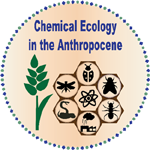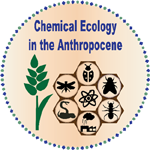From Fragrance to Function: Unraveling Specificity in Green Leaf Volatile Signaling
Silke Allmann
Green Life Sciences Research Cluster, Department of Plant Physiology, Swammerdam Institute for Life Sciences, University of Amsterdam, Amsterdam, the Netherlands
Plants can release substantial amounts of volatile compounds from their leaves into the surrounding air. When subjected to insect attacks, the composition of these volatiles undergoes significant changes. These alterations not only impact the behavior of insects interacting with the plants but also influence the metabolism of the plants themselves, as well as neighboring plants.
My research activities have been dedicated to a specific group of plant volatiles known as “green leaf volatiles” (GLVs), which are emitted immediately following herbivory. We identified a class of enzymes present in both plants and insects that play a crucial role in ecological interactions. These enzymes are responsible for converting the highly abundant green leaf volatile Z-3-hexenal into E-2-hexenal. The distinct effects of these two compounds, along with their derivatives, have significant implications for the behavior of herbivorous and predatory insects, as well as the metabolic processes of plants.
In this talk, I will provide an overview of how plants achieve specificity in their GLV signaling, explore the influence of insects on this signaling specificity, and discuss the consequences of these interactions for both plants and their biotic counterparts.
Mass spectrometry an indispensable technique for chemical ecological explorations
Athula Attygalle
Stevens Institute of Technology, Hoboken, NJ USA
E-mail: aattygal@stevens.edu
Mass spectrometry is a powerful analytical technique to characterize chemical signals used by organisms to communicate with one another. In addition, mass spectrometry enables us to decipher the biosynthetic pathways that lead to the formation of these chemicals used to attract or repel other organisms, signal danger, or mark territories. Deciphering biosynthetic pathways not only enables us to better understand the ecological interactions but also lead to developing novel pest control strategies and improve crop yields. As technology advances and new techniques are developed, mass spectrometry will continue to play a crucial role in our understanding of the natural world and the chemical interactions that shape it. In this talk, I will present many examples from my 40-year exploration on semiochemical characterization using mass spectrometry as my primary analytical tool.
Nature-based crop protection solutions for below- and above-ground plant pests
Baldwyn Torto1
1ICIPE, Behavioural and Chemical Ecology, Nairobi, Kenya
E-mail: btorto@icipe.org
Agriculture is the backbone of most African economies, and it employs 60% of the labour force, mainly small holder farmers. The sector is dominated by staple food crops including cereals and grain legumes, horticultural crops such as vegetables and fruits, and several commercial crops, namely cocoa, coffee, cotton and cashew, to name a few. However, crop production is constrained by a myriad of pest infestations and exacerbated by climate change and anthropogenic activities. To address these challenges, our research at the International Centre of Insect Physiology and Ecology (icipe), Nairobi, Kenya, focuses on developing IPM packages based on nature-based solutions as alternatives to the use of synthetic pesticides. The focus of this lecture is on our discovery and application of semiochemicals based on an understanding of the chemical ecology of key pests of some of these crops, with examples drawn for below- and above-ground pests including plant parasitic nematodes, legume pests and tephritid fruit flies.
Keywords: Plant parasitic nematodes, legume pests, tephritid fruit flies
Olfaction in Blood-feeding Arthropods: Evolutionary and Functional Insights
Zainulabeuddin Syed
Department of Entomology, University of Kentucky, Lexington, Kentucky 40546. USA
E-mail: zsy224@uky.edu
Blood feeding evolved independently several times in Arthropoda, the largest and most diverse animal phylum. From ticks to flies, arthropods display robust olfactory-driven behaviors as they track down a mate or a host and explore for a suitable habitat. However, appreciation for multimodal signaling is growing, and studying senses across arthropods offer unique insights into the origins and function of this signaling. I will present findings from our laboratory’s ongoing work, drawing upon two examples wherein olfaction acts in concert with other modalities. The blacklegged tick, Ixodes scapularis, is equipped with only ca. 20 olfactory sensilla in and around a structurally simple sensory apparatus, the Haller’s organ, that additionally contains other sensory structures contributing to a unique host-seeking strategy defined as ‘questing’. I will discuss how questing is manifested in ticks, thereby leading them to a successful exploitation of a host for blood-feeding. In the second example, I will introduce our ongoing work on exquisite mate communication strategies in sand flies. Male phlebotomine sand flies produce pheromones that serve two purposes: they act as aggregation pheromone by attracting conspecific males and also serve as a sex pheromone. In addition, males produce songs — an acoustic signal generated by vibrating their wings — during copulation. Fly populations across Brazil are shown to utilize unique combinations of these songs and pheromones to communicate. Drawing insights from the recently completed genomes, I will present detailed analyses of the chemoreceptors [odorant receptors (ORs), gustatory receptors (GRs) and ionotropic receptors (IRs)] that show unique patterns. Comparison with other sequenced Diptera revealed a large and unique expansion in sand flies where over 80% of the ~140 ORs belong to a single, taxonomically restricted clade. Analysis of single nucleotide polymorphisms (SNPs) and gene copy number in the chemoreceptors from 63 Lutzomyia longipalpis individuals provided insights into the populations that employ unique combinations of sex-aggregation pheromones and songs.
Keywords: Haller’s organ, Questing, Circadian biology, Aggregation pheromones, Sand flies

